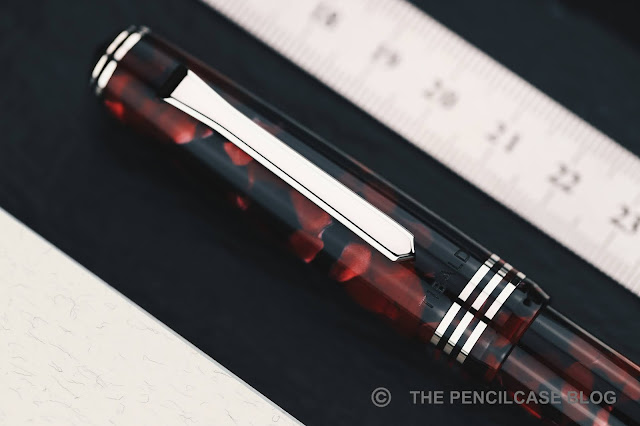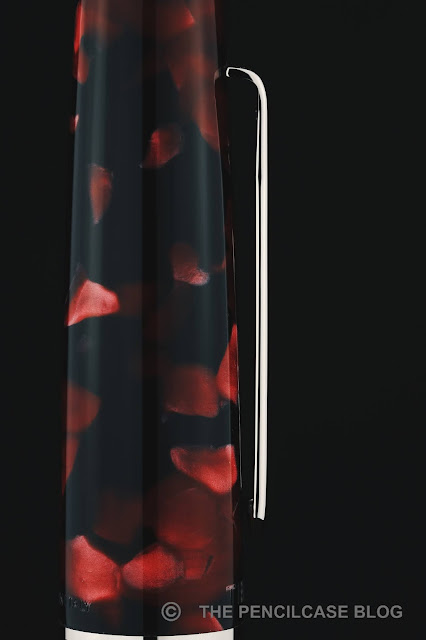Not so long ago, the Tibaldi Perfecta pleasantly surprised me (review HERE). And today we're taking a look at another Tibaldi: the N.60 (or "Modello 60") fountain pen.
With pens like the Perfecta and N.60, Tibaldi is returning to the company's roots, stepping away from the high-end pens they were known for in most recent years, and instead focusing on recreations of their own vintage designs of the previous century. I think their "re-envisioning" opened up quite a bit of potential going forward. We all know that vintage-inspired pens typically are quite well-received, and so the N.60 - in that regard - should be an interesting pen as well.
 |
| Tibaldi N.60 next to the smaller Tibaldi Perfecta |
As I said, the N.60, just like the Perfecta, is heavily drawn from vintage Tibaldi pens. I didn't know before I recently got to talking with the people of Tibaldi, but they actually have quite a long-standing history in pen manufacturing. All the way back to 1916 in fact, so there's plenty of material to draw inspiration from!
The original celluloid Modello 60, if you look it up online, is indeed immediately recognizable here. The N.60 is quite a large pen, with a subtly curved, flattop design. From to the stepped finials with 'jewel' inlays (a design element also found on vintage Esterbrooks and Parker Vacumatics, for example) on cap and barrel,...
The original celluloid Modello 60, if you look it up online, is indeed immediately recognizable here. The N.60 is quite a large pen, with a subtly curved, flattop design. From to the stepped finials with 'jewel' inlays (a design element also found on vintage Esterbrooks and Parker Vacumatics, for example) on cap and barrel,...
... the tie-shaped clip,...
....the three small cap bands, to even the pinched shape of the cap lip,... all the details of the original made its way into this design, which is really cool. I like that they stayed true to the original. Some modern interpretations seem to try too hard to do things differently, they miss the ball completely (Esterbrook JR, I'm looking at you!), and ultimately lose connection with their historical counterparts.
The design feels positively vintage, down to the material choice. Of course no longer celluloid like the vintage counterparts, but they're nice flecked resins nonetheless. I particularly like this more subtle ruby red colorway, it has some nice chatoyance in the dark red flecks. You can also go for more vibrant green or amber yellow, or perhaps the bold blue-yellow flecked 'Samarkand', which mimics one of Tibaldi's vintage transparent blue flecked celluloids (They sent me a coffee table book with information on historical models, so I can now pretend like I know these kinds of things!).
Maybe the only thing I'm not so fond of with the N.60, is the functionality of the clip. It's true to the original clip design, yes, but it's far from practical in my opinion. The clip is very springy (good), but it hugs too closely for it to actually be able to slide over the edge of a pocket or a pen case slot.
 |
| L to R: Platinum #3776, Esterbrook JR, Esterbrook Estie, Tibaldi Perfecta, Tibaldi N.60, Lamy Safari, Lamy 2000 |
For a recreation of an older pen, the N.60 may look a bit too large to really be truthful to the original. But actually, the original Modello 60 was supposedly fairly similar in size. The N.60 measures 14.9cm/ 5.87" capped, and retains a very comfortable length of 13.3cm/ 5.24" when uncapped, making it quite a sizeable pen. The section measures roughly 11.7mm/ 0.46", which is slightly on the wider side but should fit most grips quite well.
Talking about grip: writing with the N.60 is a treat! The section isn't extremely long, but it tapers nicely and flares out right before the nib. There's no step to speak of, the threads are almost not noticeable, and the fairly light total weight of 28g makes it a fatigue-free writer. I found it plenty long to use unposted, but posting is possible if you so desire.
Just like the Perfecta lacked the safety filler mechanism of its vintage counterpart, the N.60 has a standard cartridge/converter filling system instead of the original Modello 60's piston. The converter is a screw-in type, just like Montegrappa's pens (remember, Tibaldi is part of Montegrappa!), so it can't come loose accidentally. Of course, a piston filler would've been nice, but then again that would've inevitably also reflected in the price.
As mentioned in the review of the Perfecta, Tibaldi outfits their pens with steel nibs by Bock. I like the modern Tibaldi logo laser etched on the nib, but perhaps a more vintage-appropriate design would've fit the overall aesthetic a bit better?
 |
| It's good to see more and more brands go back to using ebonite feeds! |
As last time, the N.60 also benefits from an ebonite feed, which provides a fairly heavy ink flow that I like. The steel medium nib is smooth, but not glassy smooth, it has just the slightest bit of feedback to it. It's a well-behaved nib, and together with the comfortable design, the N.60 offers a very complete package for long writing sessions.
Tibaldi is specifically targeting a younger, more business-oriented audience with their new product lines, and they seem to be keen on keeping within the 150-200$ price range. The N.60 in particular, is priced very reasonably at 185€ (179$ without VAT) at Appelboom (use discount code 'friend' for 10% off!), about the same as the Tibaldi Perfecta I reviewed earlier.
I honestly have nothing but praise for what Tibaldi is doing right now. Between this and the Perfecta, they managed to perfectly capture vintage designs in well-made, modern pens. The ebonite feeds are a nice thing to see these days, they are good writers, and the price is in line with what I'd expect to pay for a pen like this. The 'new' Tibaldi brand may still need some time to regain traction with the larger audience after their complete rebranding. But the way I see it, I think they can definitely stand up to competing Italian brands like Leonardo, Maiora, and the like.













Maaaan, this would be the first Italian fountain pen that raises my eyebrow, and then they had to put a Bock nib in there. Never had any luck with either the steel or the gold Bocks... I find the pen to be pricey for a steel nib, too, but not unreasonably so.
ReplyDeleteIt's a looker, for sure! Nib lottery is a bit of a gamble (as it is with literally every brand out there, in my experience), so that's a valid concern indeed. This one was great (the ebonite feed does add to the writing experience, I find), but I've had one Tibaldi (the next one on my review list!) need some adjusting.
Delete"Cheap" or "Expensive" are such relative terms. Especially because in absolute terms, pricing has crept up over the last few years. So I try to refrain from giving opinionated comments on pricing, it's for everyone to decide for themselves. From a relative pov, I do think the N.60 is priced appropriately for a pen like this, with a steel nib - it's in line with what other (Italian) brands offer.